Question
QUESTION 1 1.Federal trademark protection: a. lasts for ten years after registration. b. can be renewed an unlimited number of times. c. can be abandoned
QUESTION 1
1.Federal trademark protection:
a.
lasts for ten years after registration.
b.
can be renewed an unlimited number of times.
c.
can be abandoned by non-use.
d.
All of these.
QUESTION 2
1.Plant patents require which of the following elements?
a.
Distinctiveness.
b.
Novelty..
c.
Nonobviousness.
d.
All of these.
QUESTION 3
1.An example of a "certification mark" would be:
a.
Holiday Inns.
b.
Nabisco.
c.
Real Cheese.
d.
Xerox.
QUESTION 4
1.In determining whether a mark is distinctive and famous under the Federal Trademark Dilution Act, a court may consider factors such as:
a.
the duration and extent of the use.
b.
the degree of recognition of the mark.
c.
the degree of inherent or acquired distinctiveness of the mark.
d.
All of these.
QUESTION 5
1.Regarding trademark protection:
a.
federal registration is required to establish rights in a mark.
b.
an owner may abandon the mark through non-use and lose protection.
c.
the owner will be presumed to have abandoned the mark after two years of non-use.
d.
All of these.
QUESTION 6
1.The Economic Espionage Act of 1996 defines theft of trade secrets to include:
a.
stealing, obtaining by fraud, or concealing such information.
b.
without authorization copying or mailing such information.
c.
purchasing or possessing a trade secret with knowledge that it has been stolen.
d.
All of these.
QUESTION 7
1.To which of the following limitations are the rights of the holder of a copyright subject?
a.
Charitable use.
b.
Compulsory licenses.
c.
Palming off.
d.
All of these.
QUESTION 9
1.The remedies for infringement under the Patent Act are:
a.
treble damages, when appropriate.
b.
fines, in cases of knowing infringement.
c.
imprisonment, in cases of knowing infringement.
d.
All of these.
QUESTION 10
1.In a disparate treatment case:
a.
if the plaintiff meets the burden of proving aprima faciecase, the burden of proof shifts to the employer.
b.
an employer will not prevail in the face of a plaintiff'sprima faciecase unless it can articulate legitimate, non-discriminatory reasons for its actions.
c.
if a plaintiff can show that a defendant's allegedly legitimate reason for not hiring plaintiff is merely a pretext for discrimination, the plaintiff wins.
d.
All of these.
QUESTION 9
1.The Supreme Court has held that the plaintiff will have shown aprima faciecase of discrimination if:
a.
she is within a protected class.
b.
she was qualified for and applied for an open position and was denied the job.
c.
after rejecting the complainant, the employer continued to try to fill the position from applicants with the complainant's qualifications.
d.
A combination of all of these.
QUESTION 11
1.After the employee has demonstrated that the employer pays unequal wages for equal work to members of the opposite sex, the burden shifts to the employer to prove that the pay differential is based on:
a.
a seniority system.
b.
a merit system.
c.
a system that measures earnings by quantity or quality of production.
d.
All of these.
QUESTION 12
1.Which of the following is NOT true about Social Security?
a.
The purpose is to provide full retirement to almost all employees.
b.
Employers and employees share the cost of contributions for the employees' benefit.
c.
Social security consists of four main programs: OASI, DI, Medicare, and SSI.
d.
Self-employed individuals pay the full cost of contributions for their benefit.
Step by Step Solution
There are 3 Steps involved in it
Step: 1

Get Instant Access to Expert-Tailored Solutions
See step-by-step solutions with expert insights and AI powered tools for academic success
Step: 2

Step: 3

Ace Your Homework with AI
Get the answers you need in no time with our AI-driven, step-by-step assistance
Get Started


